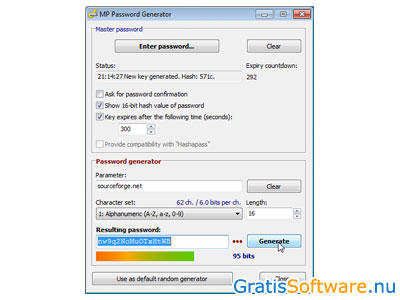

N, -num-passwords= num Generate num passwords. This is the default if the standard output is a tty device. C Print the generated passwords in columns. c, -capitalize Include at least one capital letter in the password. It may be useful for users who have bad vision, but in general use of this option is not Significantly, and as such reduces the quality of the passwords. This reduces the number of possible passwords B, -ambiguous Don't use characters that could be confused by the user when printed, such as 'l' and '1', or '0' or 'O'. a, -alt-phonics This option doesn't do anything special it is present only for backwards compatibility. A, -no-capitalize Don't bother to include any capital letters in the generated passwords. 1 Print the generated passwords one per line. Options -0, -no-numerals Don't include numbers in the generated passwords. The latter is not recommended for security reasons, since such passwords are far too easy to guess. The future, the behavior when stdout is a tty may change, so shell scripts using pwgen should explicitly specify the -nc or -0A options. This can be overriden using the -nc options. Generate less secure passwords, as if the -0A options had been passed to it on the command line.
PWGEN REVIEW PASSWORD
In addition, for backwards compatibility reasons, when stdout is not a tty and secure password generation mode has not been requested, pwgen will Order to be compatible with previous versions of this program. When standard output (stdout) is not a tty, pwgen will only generate one password, as this tends to be much more convenient for shell scripts, and in

This prevents someone from being able to "shoulder surf" the user's chosen password.

Used interactively, pwgen will display a screenful of passwords, allowing the user to pickĪ single password, and then quickly erase the screen. Standard output is a tty device or a pipe to another program. Hence, its default behavior differs depending on whether the The pwgen program is designed to be used both interactively, and in shell scripts. On the other hand, completely randomly generated passwords have a tendency to be written down, and are subject to being compromised in that fashion. Passwords generated by pwgen without the -s option should not be used in places where the password could be attacked via an off-line brute-forceĪttack. Human-memorable passwords are never going to be as secure as completely completely random passwords. Humans, while being as secure as possible. If your organization uses SSO, you’ll use your SSO login for Dashlane and won’t need to create a Master Password.The pwgen program generates passwords which are designed to be easily memorized by Dashlane encrypts all your data and never stores or transmits your Master Password, which means only you can access your vault, even in the unlikely event of a server breach. When creating an account, members that aren’t using SSO are asked to set a strong Master Password-the encryption key used to unlock the account. Admins can protect their organization by setting policies to easily onboard, offboard, and manage employees’ access to work accounts. Password managers also help businesses improve their cybersecurity. That means you’ll never have to remember or enter a complex password again. With a password manager, you can generate, save, and autofill unique, complex passwords. Plus, your information syncs seamlessly across your devices, so you’ll always have access to your logins when you need them, even if you’re offline. Password managers also enable you to share passwords with groups and individuals, so you and your team can work more efficiently. A password manager makes it easy by remembering them for you. Remembering all your work and personal passwords is difficult.


 0 kommentar(er)
0 kommentar(er)
